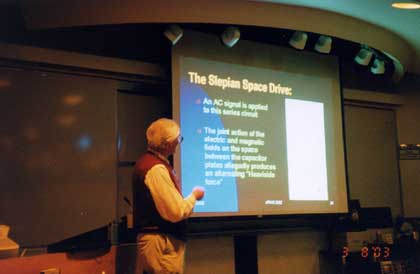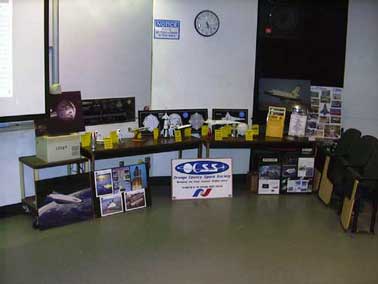






Editor: Kris Cerone
Looking for Breakthroughs
(in All the Wrong Places)
By Robert Gounley
Space travel looks hard. Going anywhere in the solar system takes big rockets. To visit the nearest star takes thousands of years by any method currently planned. Wouldn't it be great to step into the universe of a science fiction television show, where we can cross a galaxy in less time than it takes to watch a one-hour episode? Besides, aren't there scientists working on the fringes of known physics who predict that breakthrough propulsion is just around the corner or at least around the nearest wormhole?
 |
| Dr. James Woodward during presentation. Photo courtesy Craig Ward. |
We should be careful of extravagant claims advises Professor James Woodward. At an 8 March lecture hosted by OASIS and the Orange County Space Society, he explained the pitfalls of so-called "breakthrough propulsion". Most proposals, he explained, have some basis in established physics. It's in the extrapolations that eager physicists sometimes falter justifying an answer they want to obtain rather than letting the physics tell the story.
Dr. Woodward is a professor of both history and physics at the California State University, Fullerton. He takes special interest in claims of "propellantless propulsion" where experimental apparatuses allegedly manipulate electromagnetic fields in ways that generate a force in one part of the system without an equal and opposite force elsewhere in the system. He has authored several papers on "Mach's Principle" which explains inertia, the tendency of an object to resist acceleration. In theory, his analysis shows, giving an object a sudden push should create tiny, fleeting fluctuations in the objects mass. Taken further, the momentary variations could be exploited to propel an object without that object needing to expel mass like a conventional rocket engine.
 |
| OCSS display table at March lecture meeting at Cal State Fullerton. Photo courtesy Larry Evans. |
To test his analysis, Dr. Woodward has built a test apparatus that suggests mass fluctuations could exist, but definitive proof is clouded by numerous potential sources of error. The effect, if real, is quite small, probably too small to provide a meaningful propulsion system.
Nonetheless Dr. Woodward advises pursuit of this and other speculative propulsion technologies, provided it is done with careful supervision. (Until recently, NASA provided modest funds for such proposals through the Breakthrough Propulsion Physics Project run through the Glenn Research Center.) The chances for success may be small, but the potential payoffs could be staggering.
For more information on Professor Woodward and his research, see http://chaos.fullerton.edu/Woodward.html.
For more information on NASA's Breakthrough Propulsion Physics (BPP) Project, see http://www.grc.nasa.gov/WWW/bpp/
Additional photographs are in the Gallery.
Copyright © 1998-2003 Organization for the Advancement of Space Industrialization and Settlement. All Rights Reserved.